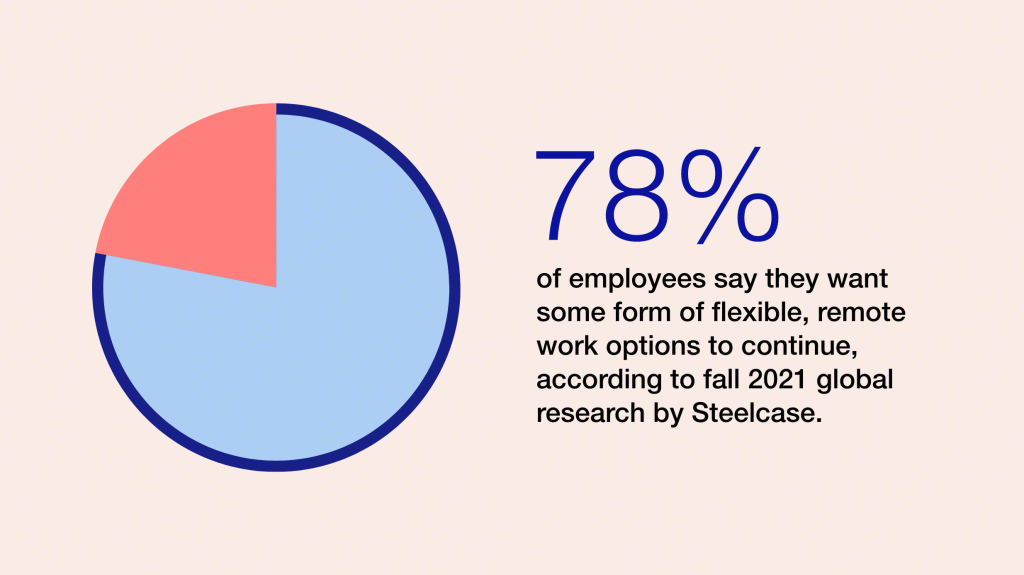Six Hybrid Work Challenges Human Resource Professionals Face Now
New research finds key hybrid work issues to resolve before they put business at risk.
“The Great Resignation” is causing upheaval in organizations everywhere. Despite efforts to secure the best talent, people continue to seek new opportunities. Their departures leave leaders searching to find, hire and train new team members all while locking down employees with critical skills they can’t afford to lose. The numbers are startling — 41% of the global workforce is likely to consider leaving their current employer in the next year, according to Microsoft data.
In response, many companies are testing the waters with a hybrid work strategy. They want to see if they can satisfy employees’ desire for flexibility in how, when and where they work while still fulfilling customer needs, creating innovative solutions and maintaining company culture. After all, 78% of employees say they want some form of flexible, remote work options to continue (Steelcase global research, Fall 2021).

Steelcase WorkSpace Futures researchers identified key areas to watch as organizations implement these hybrid models. Their latest research conducted in Fall 2021 included in-depth interviews with North American global talent experts and human resources leaders responsible for driving workplace policy and defining hybrid work models, as well as a meta-analysis of literature about effective hybrid work structures.
Structured Flexibility
There are many ways to approach hybrid work which creates significant complexity when it comes to choosing a hybrid model. What works for one organization, may not work for another based on how they are able to balance a variety of business factors. There is not one clear best hybrid model for every organization, but Steelcase researchers did see several consistent approaches emerge.
Most organizations are implementing two or three days in the office and two or three days remote. While the number of days is defined at the company level, decisions around which days people will come into the office are being made by department or regional leaders who are in a better position to understand their teams’ work and when they need to be together. The consistent insight among talent and human resource experts is that offering flexibility should not be totally open-ended. It helps employees to have some structure to let them know when other people are most likely to be in the office, so they can make connections and collaborate.
The 3-2 or 2-3 model offers more flexibility than a five-day in-office or five-day remote approach and lets organizations test new ways of working while minimizing risk to business continuity, talent strategy, overall costs and maintaining culture.
“These are complex challenges requiring leaders to meet varied criteria while considering multiple stakeholders in the context of a volatile, uncertain and complex environment.”
Mark Mortensen
Organizations are experimenting and measuring to understand the new patterns of behavior employees adopt over time.
Six Emerging Challenges with Hybrid
Within the range of new hybrid structures, Steelcase researchers noted six potential challenges organizations will likely face. Successful hybrid organizations will need to be proactive and transparent about how they are trying to address these new, critical issues.

#1 Hybrid Impacts Career Visibility. Eliminate Presence Bias.
Historically, career advancement and growth opportunities are linked to time spent in-person, gaining exposure to leaders and growing internal networks. HR leaders are seeing hybrid work colliding with talent and DEI initiatives. While talent pools can expand with some hybrid models, hybrid can also make it difficult for entry-level employees and new hires to be seen and grow in their careers. At the same time, women and people of color are more likely to opt for greater flexibility and, as a result, are less likely to be in-person and visible to leaders (Future Forum Pulse).
Bottom line: HR leaders committed to talent development, engagement and DEI goals are developing new training for hybrid leaders to address biases before they become entrenched.
#2 Equal Is Impossible. Aim for Equity.
It’s inescapable that certain jobs are more apt for remote work. Yet, providing some workers with the option to work remotely and not others can result in unintentional inequalities. Additionally, by pushing down decision making, variations will likely exist across the company. Leading organizations are accepting that, while things may not be equal, they can strive for more equity by offering different pay structures, resources or benefits to create a greater balance.
Bottom line: Employees understand things cannot always be equal, but they value organizations seeking to level the playing field.
#3 Avoid Knowledge Silos. Focus on Flow.
“Without intervention (to improve the flow of information), the effects we discovered (of siloed knowledge) have the potential to impact workers’ ability to acquire and share new information across groups, and as a result, affect productivity and innovation,” write Microsoft researchers in the journal Nature of Human Behavior.
Despite virtual collaboration tools, HR leaders continue to observe that in-person interactions remain ideal for transferring all sorts of knowledge, allowing people to learn faster and be more confident to use what they learned. This ability to share and build upon knowledge contributes to effective collaboration, reduces redundancies and improves resource efficiency. Without it, organizations risk losing the diversity of thought needed to innovate and solve complex problems. The ability for an organization to orchestrate how knowledge is made visible contributes significantly to its success. Hybrid makes this exceedingly more difficult and requires leaders to put a greater focus on building collective knowledge.
Bottom line: Organizations that have already undergone digital transformation, and have processes and tools in place to make it easier to access information, are better positioned to avoid knowledge silos. For those that have not, hybrid work will accelerate their need to restructure and invest in collective learning and broadening network connections.
#4 Less Predictable Work. More Intentional Experiences.
The days and times people go into the office will vary in a hybrid model, so they will be less likely to bump into one another — especially people outside their immediate teams. And as people become more deliberate about when and why they come to the office, they will have new expectations about the space and tools they need. Leading organizations are responding by redesigning their spaces to better support hybrid work and creating experiences that help build a culture of trust and a sense of community, which could erode when people spend less time together.
Bottom line: Less predictable daily work behaviors will require space and tools to be more adaptive and flexible to respond to what people need in the moment. Feedback will be critical to managing both the physical environment and workplace experience.
#5 Distance Weakens Bonds. Build Social Capital.
Hybrid models will result in less shared experiences that build social capital. “Even though everyone could connect, and we’ve got these technologies, the social connectedness scores were just horrible in our pulse surveys because we’re just not conditioned well to operate and stay connected with our employees that way,” says one Steelcase research participant.
People work for, and are motivated by other people which means to feel engaged and loyal to the organization, they need to feel connected to others. Laughing over a cup of coffee or discussing an issue over a meal creates the relationship glue that leads to trust — a key ingredient to engagement, retention and innovation.
Bottom line: HR leaders worry a distributed workforce will make it harder to build social capital and more difficult to onboard new employees into the existing culture. Leaders understand the need to rebuild weakened social bonds and are leveraging the power of the physical environment to strengthen culture.
#6 Basics Aren’t Enough. Support the Whole Person.
People have greater expectations about the role their organization takes in supporting their overall sense of wellbeing. Flexibility — whether organizations adopt a formal hybrid policy or simply allow for more remote work or flexible work schedules — is becoming the new table stakes for attracting and retaining talent because people are not willing to give up their new sense of autonomy and greater work-life balance. People are also looking for more than the basic benefits package from their organization. A new social contract is emerging in which companies support their employees’ body, mind and spirit in totality.
Bottom line: HR leaders understand employee wellbeing is now an issue organizations will need to support in concrete and meaningful ways. A range of new benefits are being explored including sabbatical leave, mindfulness training, child care and rejuvenation experiences in the office.
Organizations that adopt hybrid work policies may see these and other challenges emerge. Anticipating and planning ahead for these issues before they arise will enable companies to be far better positioned to attract and retain talent, maintain business continuity and act quickly to achieve successful results for their people and their business.


